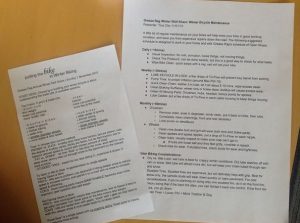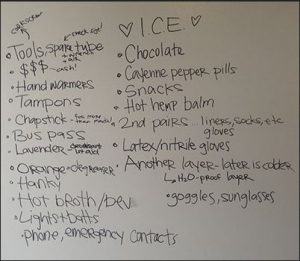By Sophie
I’m the kind of person who talks a lot about doing things before I actually do them. Case in point: Last year I spent a lot of time asking friends, coworkers, and random passersby about winter biking, but I only did it about 10 times between first and last snow.
So I was super excited to go to Grease Rag’s Winter Skill Share. Having a whole day dedicated to all of the variables in winter biking made me feel like this year, maybe I’d feel equipped enough to do it on a regular basis. The whole day made me feel like not only is winter biking a viable option, it’s a fun one.

Safety & Handling
First, I attended “Safety and Handling” with Kat. You can see a handout with important notes here. A few things stood out from the presentation, and the discussion afterwards. First, the suggestion that lowering my seat would give me better balance (lower center of gravity) and help prevent falls (easier to catch myself). Kat also stressed the importance of keeping the weight of our bike baggage evenly distributed. Carrying one pannier, as I often do, might cause me to tip over in that direction when turning on icy streets. So Kat suggested adding another pannier and evenly distributing weight between them, or switching to a backpack.
Planning our routes also came up a lot. As great as bike lanes are when roads are clear, they often become dumping grounds for snow plows in the winter. Kat suggested that cyclists might have to just take the lane, saying, “I’m not willing to ride where the bike lane used to be.” Another person in the room also had a great suggestion: that if we know the route we’ll be riding on a regular basis, we can ride it during wet, pre-snow weather to see if there are places where water tends to collect. That way we’ll know generally where the road may ice over once it goes below freezing.
Maintenance
Next was “Bike Maintenance” with Janni and Tina. I appreciated seeing a variety of winter bike setups, because they were all so different but worked for each owner. Janni said people shouldn’t feel discouraged about getting the “right” winter bike, because “when someone says, ‘this is what a winter bike should look like,’ they mean that’s what works for them.”
Tina gave us a comprehensive “Maintenance Calendar” to keep our bikes moving and grooving. It includes when and how to wash and lubricate different parts, daily, weekly, and monthly tasks, as well as gear recommendations.
While there were great points about all different bike setups, I came away thinking that I want a single speed bike with big tires this winter. The stability of wide tires appeals to me a lot, even if it’s slower. And while I usually love having gears, I don’t trust myself to keep up the maintenance needed for a geared bike in the winter. I don’t even trust myself to wipe the salt from my bike every day.
Tina and Janni also had some great suggestions for an “I.C.E.” (In Case of Emergency) kit. While I usually carry an extra tube, tire levers and a little pump, I wasn’t particularly looking forward to changing a flat in sub zero weather. Janni and Tina suggested carrying a pair of nitrile gloves (like hospital gloves) for changing flats, because those will keep hands warm even in the coldest weather.

Another way to keep warm: non-metal pedals. Janni said that metal pedals can leach heat through our feet if our shoe soles aren’t thick enough. The fix: pedals made out of materials like plastic, or wearing shoes with really thick soles.
I’ll see you all out on the snowy streets…although you probably won’t recognize me because I’ll be wearing a balaclava. Happy riding.
